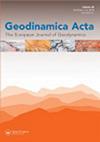The geology and morphology of the Antakya Graben between the Amik Triple Junction and the Cyprus Arc
IF 1.5
Q1 Earth and Planetary Sciences
引用次数: 30
Abstract
In southeastern Turkey, the NE-trending Antakya Graben forms an asymmetric depression filled by Pliocene marine siliciclastic sediment, Pleistocene to Recent fluvial terrace sediment, and alluvium. Along the Mediterranean coast of the graben, marine terrace deposits sit at different elevations ranging from 2 to 180 m above present sea level, with ages ranging from MIS 2 to 11. A multisegmented, dominantly sinistral fault lying along the graben may connect the Cyprus Arc in the west to the Amik Triple Junction on the Dead Sea Fault (DSF) in the east. Normal faults, which are younger than the sinistral ones, bound the graben’s southeastern margin. The westward escape of the continental İskenderun Block, delimited by sinistral fault segments belonging to the DSF in the east and the Eastern Anatolian Fault in the north caused the development of a sinistral transtensional tectonic regime, which has opened the Antakya Graben since the Pliocene. In the later stages of this opening, normal faults developed along the southeastern margin that caused the graben to tilt to the southwest, leading to differential uplift of Mediterranean coastal terraces. Most of these normal faults remain active. In addition to these tectonic movements, Pleistocene sea level changes in the Mediterranean affected the geomorphological evolution of the area.安塔基亚地堑的地质和形态在阿米克三结和塞浦路斯弧之间
在土耳其东南部,北东向的Antakya地堑形成了一个由上新世海相硅质碎屑沉积、更新世至近代河流阶地沉积和冲积物充填的不对称坳陷。在地堑的地中海沿岸,海相阶地沉积位于比现在海平面高2到180米的不同高度,年龄从MIS 2到11不等。一条多节段的左旋断层沿地堑分布,可能将西部的塞浦路斯弧与东部死海断层(DSF)上的阿米克三结连接起来。在地堑东南边缘,正断层比左断层更年轻。大陆块体İskenderun向西伸展,东部属于DSF的左旋断裂段和北部属于东安纳托利亚断裂段,形成了一个左旋张性构造体系,自上新世以来打开了Antakya地堑。在裂口后期,东南缘正断层发育,使地堑向西南倾斜,形成地中海沿岸阶地的差别性隆升。这些正常断层中的大多数仍然活跃。除了这些构造运动外,地中海更新世海平面的变化也影响了该地区的地貌演化。
本文章由计算机程序翻译,如有差异,请以英文原文为准。
求助全文
约1分钟内获得全文
求助全文
来源期刊

Geodinamica Acta
地学-地球科学综合
CiteScore
4.50
自引率
0.00%
发文量
0
审稿时长
25 weeks
期刊介绍:
Geodinamica Acta provides an international and interdisciplinary forum for the publication of results of recent research dealing with both internal and external geodynamics. Its aims to promote discussion between the various disciplines that work on the dynamics of the lithosphere and hydrosphere. There are no constraints over themes, provided the main thrust of the paper relates to Earth''s internal and external geodynamics. The Journal encourages the submission of papers in all fields of earth sciences, such as biostratigraphy, geochemistry, geochronology and thermochronology, geohazards and their societal impacts, geomorphology, geophysics, glaciology, igneous and metamorphic petrology, magmatism, marine geology, metamorphism, mineral-deposits and energy resources, mineralogy, orogeny, palaeoclimatology, palaeoecology, paleoceanograpgy, palaeontology, petroleum geology, sedimentology, seismology and earthquakes, stratigraphy, structural geology, surface processes, tectonics (neoteoctonic, plate tectonics, seismo-tectonics, Active tectonics) and volcanism.
Geodinamica Acta publishes high quality, peer-reviewed original and timely scientific papers, comprehensive review articles on hot topics of current interest, rapid communications relating to a significant advance in the earth sciences with broad interest, and discussions of papers that have already appeared in recent issues of the journal. Book reviews are also included. Submitted papers must have international appeal and regional implications; they should present work that would be of interest to many different specialists. Geographic coverage is global and work on any part of the world is considered. The Journal also publishes thematic sets of papers on topical aspects of earth sciences or special issues of selected papers from conferences.
 求助内容:
求助内容: 应助结果提醒方式:
应助结果提醒方式:


